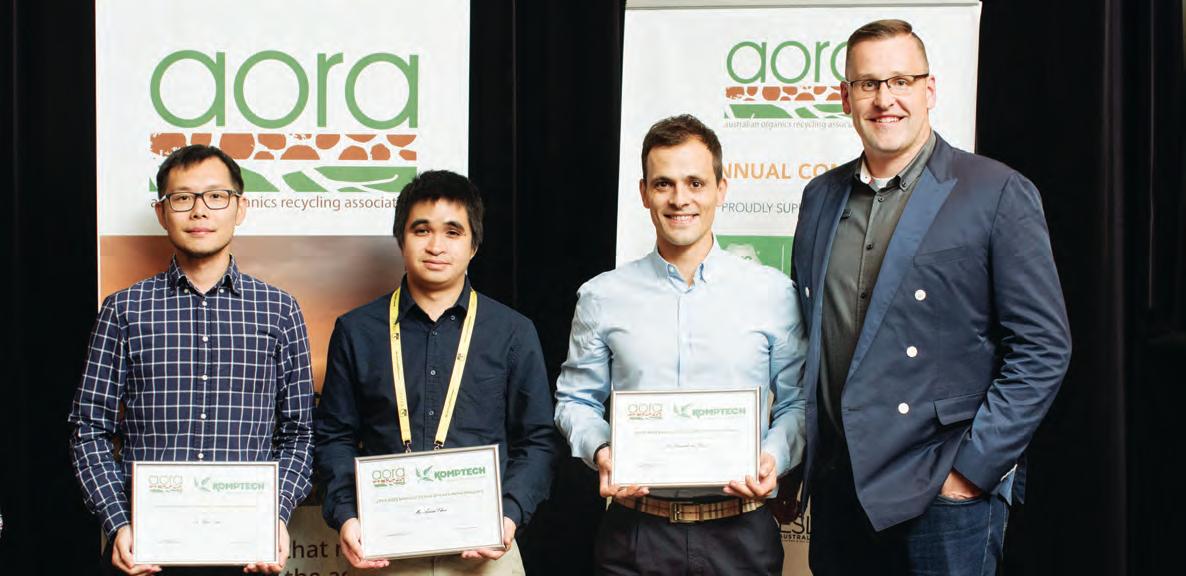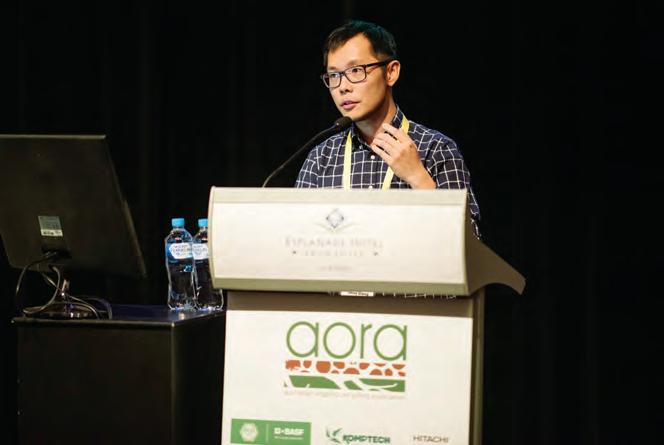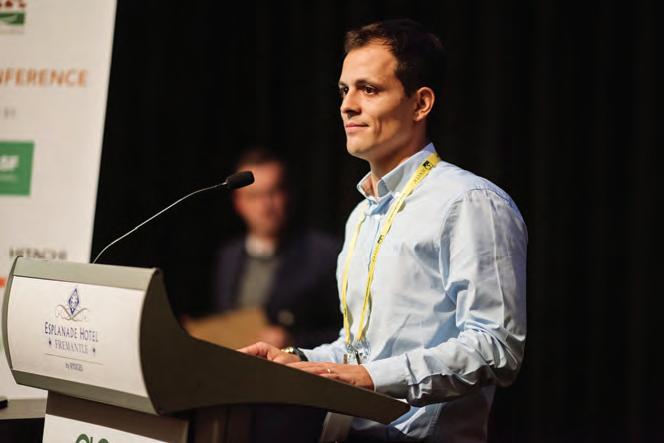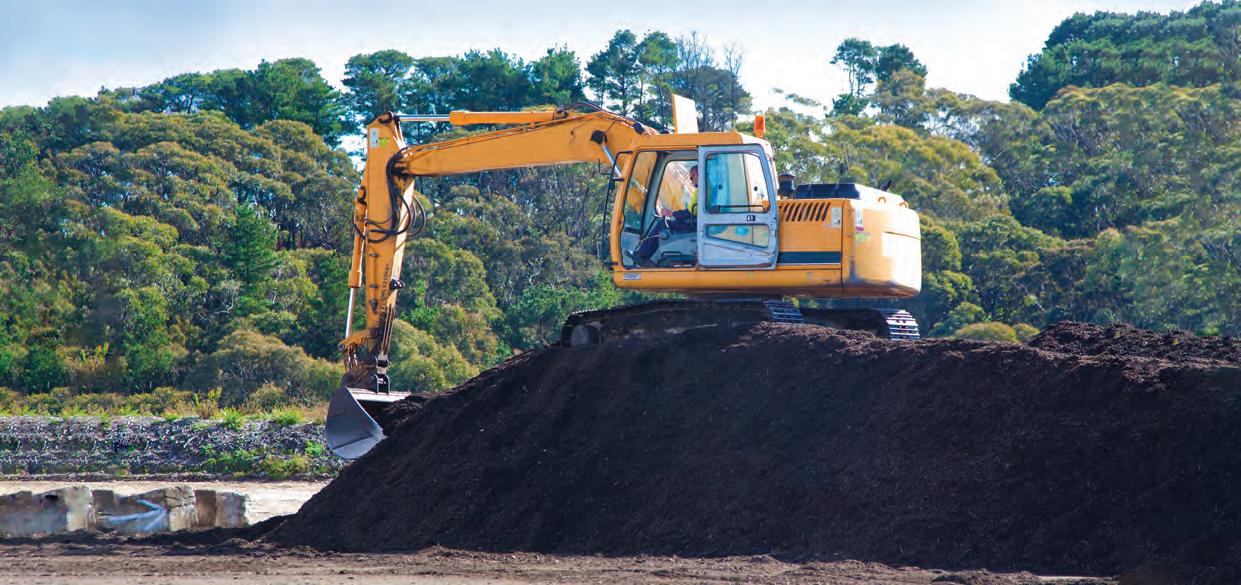
13 minute read
TAKING RESEARCH TO MARKET
Shao Yap, Aidan Chin, Daniele De Rosa won awards in the inaugural AORA Student Research Awards, with ELB Equipment’s Christopher Malan sponsoring the award through Komptech.
THE AORA STUDENT RESEARCH AWARDS FOR ADVANCING ORGANICS RECYCLING HAVE RECOGNISED THREE SCHOLARS FOR CRITICAL EMISSIONS-REDUCTION RESEARCH. T hroughout the 1950s and 60s, the Green Revolution spread worldwide in response to global food shortages cause by population growth, namely through Mexico and the Indian subcontinent.
According to a research paper published in PNAS Journal on the Green Revolution, the developing world saw extraordinary food crop productivity gains despite growing land scarcity and rising land values.
But in order to achieve such growth, farmers increasingly relied on synthetic nitrogen products, with the perverse outcome being an increase in global emissions.
These are the outcomes generated from Dr Daniele De Rosa’s research into optimising organic amendments to reduce emissions.
Daniele is part of a research team at the Queensland University of Technology and recently won an Australian Organics Recycling Association (AORA) Student Research Award presented at this year’s AORA State Conference.
The inaugural awards are sponsored by Komptech and administered by the University of Queensland’s Centre for Recycling of Organic Waste and Nutrients (CROWN).
Postgraduate research and runner up categories and honours category were handed to three scholars for a diverse range of organics reuse projects. All project nominations were put forward in collaboration with the respective supervisors at each university.
Daniele, winner of the postgraduate research award, conducted research that looked at the possibility of accounting for nutrient inputs following the use of raw and composted manures in intensive horticulture. This was done in combination with reduced fertiliser inputs without reducing crop yields and without increasing greenhouse gas emissions.
His project was part of the National Agricultural Manure Management Program (NAMMP), which was funded by the Federal Government and the intensive animal industries, and aimed to find ways of reducing greenhouse gas emissions from Australia’s agricultural sector.
“My main goal is to see sustainable agriculture. If we want to survive on this planet for the next 200 to 300 years, we need to become more sustainable,” Daniele explains.
His research explains that during the Green Revolution, farmers had
increased their use of synthetic nitrogen fertiliser to maximise the yield potential of new varieties.
Nitrogen (N) is the primary plant macronutrient for crop production and farmers generally supply N to agricultural soils as synthetic N-fertiliser. His research paper explains that as N-fertiliser is the main source of reactive N in the global N cycle, it is typically produced by industrial fixation – a synthetic method of converting atmospheric nitrogen to nitrogen oxides or ammonium ions to stimulate plant growth.
Before synthetic N fertiliser was introduced, applying organic amendments such as animal manures to agricultural soils were a traditional method of fertilising crops. Daniele’s research illustrates that farmers typically use organic amendments to increase soil organic matter levels and soil structure, but neglect to account for nutrients, particularly nitrogen inputs that can cause soil and environmental degradation.
“The main problem was for the last 30 to 40 years we didn’t have much knowledge about carbon or nutrient losses. The point of agriculture is to improve crop yield and therefore water retention.
He says that its important to understand that while a better yield was achieved, it was not sustainable in the long-term and risked degrading soils.
Given the exponential increase in animal manure due to soaring global meat production, Daniele and his colleagues determined that partially replacing mineral N-fertiliser with organic amendments such as raw and composted manures would reduce the environmental burden of industrial N fixation. Importantly, the beneficial reuse of organics led to a win-win situation.
The study was conducted at Gatton Research Station in the Lockyer Valley in Queensland between 2013 and 2016. The area is a major vegetable producing region in South East Queensland characterised by a humid subtropical climate. stubble, faeces, urine and other products, is a major by-product of Australian livestock farming. The key concerns with this are uncontrolled greenhouse gas emissions, pest propagation, odour and nutrient leaching to groundwater.
Shao’s project, also carried out as part of NAMMP between 2013-17, looked at how a leachbed anaerobic digestion approach suitable for high
PhD Dr Daniele De Rosa Queensland University of Technology Research Team
The researchers monitored the annual application of composted and raw manure combined with a conventional and reduced rate of synthetic N fertilisers. Greenhouse gas emissions, soil N content and its impact on crop production were monitored in eight vegetable crops over a 2.5-year rotation.
The results found no difference in nitrous oxide emission and crop yield compared to conventional N management.
Daniele says that explaining the benefits to farmers will become increasingly important in ensuring the research is applied practically.
ANAEROBIC DIGESTION Dr Shao Yap, University of Queensland graduate, won the runnerup postgraduate prize for anaerobic treatment of solid manure residues. Spent bedding, a mix of bedding solids waste such as spent bedding could be cost-effective to construct and operate over alternatives. The biogas output provides a financial incentive for farmers to establish such a system by reducing on-farm energy costs.
He says the traditional method of managing spent bedding has been to put it to land and let it dry, which carries with it an environmental risk. Leaving this on the farm can create leachate which can contaminate the groundwater.
Pilot trials showed a potential 50 per cent methane recovery.
Shao says that 50 per cent methane recovery from spent bedding is a result that can be reasonably achieved with minimal labour. More research is needed to demonstrate the commercial value of 100 per cent.
Process performance was hindered in Shao’s trials by insufficient solid-
liquid contact through biological inhibition due to dissolved organic compounds, including ammonia and humic substances.
He recommends future research should explore treatment options and strategies to manage inhibitor accumulation in the process. IN-SITU SOILS Aidan Chin, PhD candidate at the University of Queensland, won the honours category for research he conducted in 2017. He explored methodologies to formulate and test next-generation fertilisers based on organic residues to improve plant nutrient use efficiency and advance towards a more circular nutrient economy.
The research found that delivering nutrients from mineral or organic fertilisers out of synchrony with crop uptake causes inefficiencies and pollution.
“When nitrogen is applied into the soil it quickly transforms into forms that are really mobile and easily lost, like ammonia and nitrous oxide, which can be volatilised and lost into the air, or nitrate, which is easily lost in heavy rainfall,” Aidan explains.
He adds that nitrate can lead to groundwater pollution while nitrous oxide is a powerful gas that has 300 times the global warming potential of CO2.
“Nitrogen is a valuable resource in soils for plants, so we need to make sure it’s converted to forms that are less vulnerable to loss processes.”
The research, published in Science of the Total Environment , explored methodologies for evaluating sorbents as additives to organic agricultural residues to retain nitrogen in an exchangeable form.
It focused on ammonium as the main inorganic nitrogen form in studied wastes, including sugarcane mill mud and poultry litter, and tested geosorbents including biochar for their ability to retain ammonium.
“We looked at the industries around the sugar-cane-producing region that produced organic residues with the idea to reuse the valuable nutrients in our fertiliser formulations.
“We settled on mill mud from sugarcane processing and poultry litter,” he says.
He says efforts to formulate organicbased fertilisers for specific regions should take advantage of the residues and by-products generated by local agriculture and industry to minimise transport costs.
The sorbent-residue formulations were analysed for sorption capacity, leaching and ammonium fluxes. Sorbents with stronger ammonium sorption capacity demonstrated greater potential in both reducing ammonium leaching and producing ammonium fluxes that more closely Dr Daniele De Rosa conducted research that looked at the possibility of accounting for nutrient inputs following the use of raw and composted manures in intensive horticulture. Dr Shao Yap looked at how a leachbed anearobic digestion approach suitable for high solids waste could be cost effective to construct and operate.


matched the uptake capacity of roots. Roots preferentially colonised stronger sorbent-residue formulations and avoided weaker ones, which suggested lower ammonium fluxes generated a more favourable growth environment.
AORA Chair Peter Wadewitz says that science is playing a bigger role every day in the organics recycling industry.
“The markets are demanding knowledge about what our products can and can’t do,” Peter says.
Peter says the students did a brilliant job and demonstrated expert knowledge of their subject matter.
Johannes Biala, Director of CROWN, who managed the awards nomination and selection process, says that processing organic residues and the beneficial use of recycled organic products are, by and large, not on the radar of students in Australia.
“I am sure that this award program will raise the profile of working in the realm of organics recycling within universities and among students, and hopefully turn the tide,” Johannes says.
“The awards are open to postgraduate students at Honours, Masters and PhD level enrolled at an Australian or New Zealand university, who have carried out postgraduate work that advances organics recycling supply chains at any level.”
Christopher Malan, Managing Director of ELB Equipment and authorised Australian Komptech distributor, says that Joseph Heissenberger founded Komptech with the statement: “Someday our grandchildren will ask us what we did with their future.”
“Today, Komptech is answering that question by relentlessly pursuing innovation towards ensuring a greener future,” Christopher says.
“Supporting the AORA Student Research Awards is an obvious extension of the company’s mission.
“It enhances the effectiveness of AORA – an organisation that may be doing more for the environment in Australia than any other.”
Christopher says the awards also promote innovation in sustainability and environmental health by recognising and rewarding the efforts of young researchers in the field.
“ELB and Komptech are delighted with the quality of the research and presentations of the three winners and are looking forward to the continued growth and success of the programs.”
Skill-up and start producing high quality compost!

The NSW EPA’s free Compost Facility Management Course can improve your knowledge and skills to manage and operate a compost processing facility. This interactive online course can be done at your own pace at a time and place that suits you. Register now at https://learning.epa.nsw.gov.au and search for the Compost Facility Management Course.
Let’s chat compost
THE NSW ENVIRONMENT PROTECTION AUTHORITY HAS DEVELOPED AN ENGAGING CONVERSATIONAL LEARNING PROGRAM TO SUPPORT PROFESSIONAL DEVELOPMENT IN THE ORGANICS SECTOR.
Simulated conversational experiences, or chatbots, have been gaining traction across numerous industries.
Conversational learning is a unique concept that delivers knowledge in focused, micro-learning chunks, requiring only three to five minutes of a learner’s time. It aims to put learners in control, use conversation and story-telling to stimulate engagement, build knowledge and allow for active discovery and decision making.
With an increase in chatbot messenger apps offering instantaneous customer service, news and other relevant notifications, chatbot experiences are even making inroads in the waste sector.
To support the compost industry, e-learning provider IMC has been working with the Environment Protection Authority (EPA) via its organics program. IMC and the EPA have developed four-five minute chatbot modules dubbed “Let’s Chat Compost” on the topics of assessing odour, pasteurisation, composting and managing contamination.
The learning sessions aim to simulate ordinary conversations, akin to those you’d have with a friend or colleague – personal, fun and to the point. They embed personality into the learning content and create a dynamic interaction like one-on-one teaching, making social and interactive e-learning “in dialogue” possible.
The Let’s Chat Compost modules allow users to continue or refresh their learning through the EPA’s existing Compost Facility Management eLearning program, released at the end of last year.
Presented in social media messenger style, the app uses conversation and memes to engage learners to expand on their composting knowledge.

The Compost Facility Management course comprises seven modules and has been designed for regulators and people in all roles working in organics facilities. It uses interactive content, animation and video to engage learners, with the aim of embedding high-level skills and knowledge for best practice facility management.
IMC has leveraged its expertise from working with clients such as National Rugby League, the Department of Health and Human Services, BMW, Mercedes Benz and Audi to craft unique and conversational learning experiences.
Amanda Kane, Organics Manager at the NSW EPA, says Let’s Chat Compost aims to draw attention to the key processes most relevant to processors, regulators, local government, consultants and waste collection operators.
“Let’s Chat Compost will be a tool to reinforce learning and act as a reminder for what’s happening inside a compost pile that might be causing an odour, or why it’s important to manage contamination and the importance of pasteurisation,” Amanda says.
“IMC’s concept was developed in Germany and designed to look as much like a phone chat as possible. It was in recognition of the platforms we use in everyday life.”
She says that developing smartphone nuggets is an exercise in communicating the most important content in an engaging way.
“The main goal of the nuggets is to get people to take up the course, but also as a reminder for those that have completed the course,” Amanda says.
The app can send notifications to those who have completed the course, encouraging them to share the modules with their colleagues or revisit aspects of their learning.
Amanda adds that companies
Let’s Chat Compost helps users develop new skills and behaviours.
could adapt the program to suit their organisational tone and include additional relevant occupational health and safety and company information.
“The result is not only contributing to the production of a quality product, but upskilling the industry and minimising the environmental impact of one’s operations.
“It’s critical that processors are operating within the conditions of their license, and that if any issues do arise, they know how to respond and communicate with the EPA and advise us what’s happening.”
She says that the smartphone nuggets are aimed to be accessible on multiple devices and link back to course content.
The modules also include expert tips from industry leaders such as SOILCO and Australian Native Landscapes (ANL).
“We wanted to have industry voices to communicate those messages. All

of the course content was filmed at sites around NSW using various technologies,” Amanda says.
“These include ANL’s open windrow or the in-tunnel systems that JR Richards & Sons have up at Grafton and then using team members at all levels to communicate the message, including EPA regulatory staff as well.
“We have had 300 people sign up, and the overall feedback is that people are finding it to be a rewarding learning experience.”
EVA Environmental Director Geraldine Busby, who also worked on the initial training course, oversaw the development of smartphone nuggets.
Carmen Locke, Instructional Designer, IMC AG, says conversational learning allows learners to make decisions while being actively immersed in a one-on-one learning scenario. This increases their ability to retain content, understand concepts and develop new skills and behaviours.





